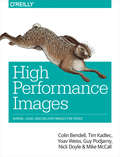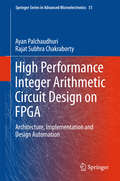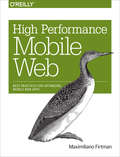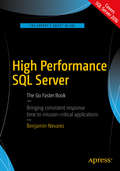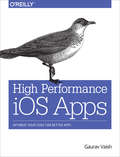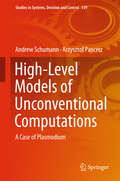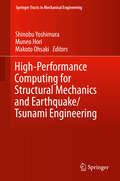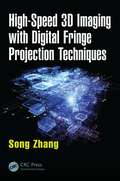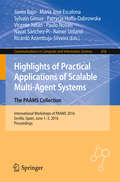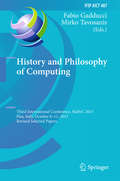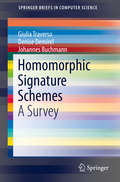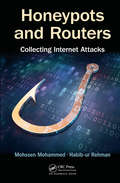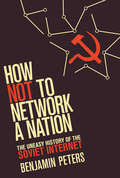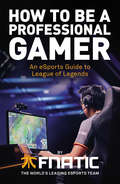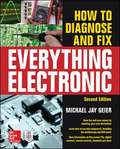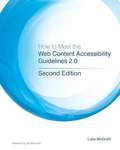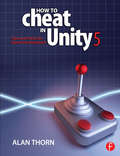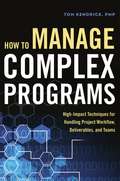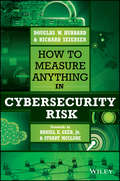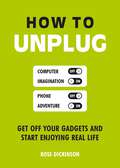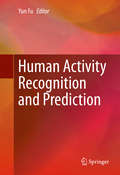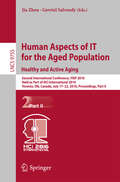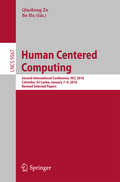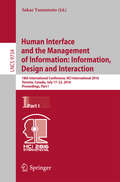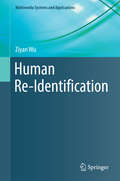- Table View
- List View
High Performance Images: Shrink, Load, and Deliver Images for Speed
by Guy Podjarny Nick Doyle Tim Kadlec Colin Bendell Yoav Weiss Mike McCallHigh-quality images have an amazing power of attraction. Just add some stunning photos and graphics to your website or app and watch your user engagement and conversion numbers climb. It can be tricky, but with this practical guide, you’ll master the many facets of delivering high performance images on the internet—without adversely affecting site performance.You’ll learn the nuts and bolts of color theory, image formats, storage and management, operations delivery, browser and application behavior, the responsive web, and many other topics. Ideal for developers, this book also provides useful tips, tricks, and practical theory for processing and displaying powerful images that won’t slow down your online product.Explore digital image theory and the different formats availableDive into JPEGs, SVG and vector images, lossless compression, and other formatsUse techniques for downloading and rendering images in a browser, and for loading images on mobile devices and cellular networksExamine specific rendering techniques, such as lazy loading, image processing, image consolidation, and responsive imagesTake responsive images to the next level by using content negotiation between browser and server with the Client Hints HTTP standardLearn how to operationalize your image workflowContributors include Colin Bendell, Tim Kadlec, Yoav Weiss, Guy Podjarny, Nick Doyle, and Mike McCall from Akamai Technologies.
High Performance Integer Arithmetic Circuit Design on FPGA
by Ayan Palchaudhuri Rajat Subhra ChakrabortyThis book describes the optimized implementations of several arithmetic datapath, controlpath and pseudorandom sequence generator circuits for realization of high performance arithmetic circuits targeted towards a specific family of the high-end Field Programmable Gate Arrays (FPGAs). It explores regular, modular, cascadable and bit-sliced architectures of these circuits, by directly instantiating the target FPGA-specific primitives in the HDL. Every proposed architecture is justified with detailed mathematical analyses. Simultaneously, constrained placement of the circuit building blocks is performed, by placing the logically related hardware primitives in close proximity to one another by supplying relevant placement constraints in the Xilinx proprietary "User Constraints File". The book covers the implementation of a GUI-based CAD tool named FlexiCore integrated with the Xilinx Integrated Software Environment (ISE) for design automation of platform-specific high-performance arithmetic circuits from user-level specifications. This tool has been used to implement the proposed circuits, as well as hardware implementations of integer arithmetic algorithms where several of the proposed circuits are used as building blocks. Implementation results demonstrate higher performance and superior operand-width scalability for the proposed circuits, with respect to implementations derived through other existing approaches. This book will prove useful to researchers, students and professionals engaged in the domain of FPGA circuit optimization and implementation.
High Performance Mobile Web: Best Practices for Optimizing Mobile Web Apps
by Maximiliano FirtmanOptimize the performance of your mobile websites and webapps to the extreme. With this hands-on book, veteran mobile and web developer Maximiliano Firtman demonstrates which aspects of your site or app slow down the user’s experience, and what you can do to achieve lightning-fast performance. There’s much at stake: if you want to boost your app’s conversion rate, then tackling performance issues is the best way to start.Learn tools and techniques for working with responsive web design, images, the network layer, and many other ingredients—plus the metrics to check your progress. Ideal for web developers and web designers with HTML, CSS, JavaScript, and HTTP experience, this is your guide to superior mobile web performance.You’ll dive into:Emulators, simulators, and other tools for measuring performanceBasic web performance concepts, including metrics, charts, and goalsHow to get real data from mobile browsers on your real networksAPIs and specs for measuring, tracking and improving web performanceInsights and tricks for optimizing the first view experienceWays to optimize post-loading experiences and future visitsResponsive web design and its performance challengesTips for extreme performance to achieve best conversion ratesHow to work with web views inside native apps
High Performance SQL Server
by Benjamin NevarezDesign and configure SQL Server instances and databases in support of high-throughput applications that are mission-critical and provide consistent response times in the face of variations in user numbers and query volumes. Learn to configure SQL Server and design your databases to support a given instance and workload. You'll learn advanced configuration options, in-memory technologies, storage and disk configuration, and more, all toward enabling your desired application performance and throughput. Configuration doesn't stop with implementation. Workloads change over time, and other impediments can arise to thwart desired performance. High Performance SQL Server covers monitoring and troubleshooting to aid in detecting and fixing production performance problems and minimizing application outages. You'll learn a variety of tools, ranging from the traditional wait analysis methodology to the new query store, and you'll learn how improving performance is really an iterative process. High Performance SQL Server is based on SQL Server 2016, although most of its content can be applied to prior versions of the product. This book is an excellent complement to performance tuning books focusing on SQL queries, and provides the other half of what you need to know by focusing on configuring the instances on which mission-critical queries are executed. Covers SQL Server instance-configuration for optimal performance Helps in implementing SQL Server in-memory technologies Provides guidance toward monitoring and ongoing diagnostics What You Will Learn Understand SQL Server's database engine and how it processes queries Configure instances in support of high-throughput applications Provide consistent response times to varying user numbers and query volumes Design databases for high-throughput applications with focus on performance Record performance baselines and monitor SQL Server instances against them Troubleshot and fix performance problems Who This Book Is For SQL Server database administrators, developers, and data architects. The book is also of use to system administrators who are managing and are responsible for the physical servers on which SQL Server instances are run.
High Performance iOS Apps: Optimize Your Code for Better Apps
by Gaurav VaishReady to build mobile apps that out-perform the rest? If you’re an iOS developer with app-building experience, this practical guide provides tips and best practices to help you solve many common performance issues. You’ll learn how to design and optimize iOS apps that deliver a smooth experience even when the network is poor and memory is low.Today’s picky users want fast and responsive apps that don’t hog resources. In this book, author Gaurav Vaish demonstrates methods for writing optimal code from an engineering perspective, using reusable Objective-C code that you can use right away. Up your game and create high-performance native iOS apps that truly stand out from the crowd.Measure key performance indicators—attributes that constitute and affect app performanceWrite efficient apps by minimizing memory and power consumption, and explore options for using available CPU coresOptimize your app’s lifecycle and UI, as well as its networking, data sharing, and security featuresLearn about application testing, debugging and analysis tools, and monitoring your app in the wildCollect data from real users to analyze app usage, identify bottlenecks, and provide fixesUse iOS 9 upgrades to improve your app’s performance
High-Level Models of Unconventional Computations: A Case Of Plasmodium (Studies in Systems, Decision and Control #159)
by Krzysztof Pancerz Andrew SchumannThis book shows that the plasmodium of Physarum polycephalum can be considered a natural labelled transition system, and based on this, it proposes high-level programming models for controlling the plasmodium behaviour. The presented programming is a form of pure behaviourism: the authors consider the possibility of simulating all basic stimulus–reaction relations. As plasmodium is a good experimental medium for behaviouristic models, the book applies the programming tools for modelling plasmodia as unconventional computers in different behavioural sciences based on studying the stimulus–reaction relations. The authors examine these relations within the framework of a bio-inspired game theory on plasmodia they have developed i.e. within an experimental game theory, where, on the one hand, all basic definitions are verified in experiments with Physarum polycephalum and Badhamia utricularis and, on the other hand, all basic algorithms are implemented in the object-oriented language for simulations of plasmodia. The results allow the authors to propose that the plasmodium can be a model for concurrent games and context-based games.
High-Performance Computing for Structural Mechanics and Earthquake/Tsunami Engineering
by Makoto Ohsaki Shinobu Yoshimura Muneo HoriHuge earthquakes and tsunamis have caused serious damage to important structures such as civil infrastructure elements, buildings and power plants around the globe. To quantitatively evaluate such damage processes and to design effective prevention and mitigation measures, the latest high-performance computational mechanics technologies, which include telascale to petascale computers, can offer powerful tools. The phenomena covered in this book include seismic wave propagation in the crust and soil, seismic response of infrastructure elements such as tunnels considering soil-structure interactions, seismic response of high-rise buildings, seismic response of nuclear power plants, tsunami run-up over coastal towns and tsunami inundation considering fluid-structure interactions. The book provides all necessary information for addressing these phenomena, ranging from the fundamentals of high-performance computing for finite element methods, key algorithms of accurate dynamic structural analysis, fluid flows with free surfaces, and fluid-structure interactions, to practical applications with detailed simulation results. The book will offer essential insights for researchers and engineers working in the field of computational seismic/tsunami engineering.
High-Speed 3D Imaging with Digital Fringe Projection Techniques (Optical Sciences and Applications of Light)
by Song ZhangDigital fringe projection (DFP) techniques are used for non-contact shape measurement of 3D images. In the rapidly expanding field of 3D high-speed imaging, the demand for DFP continues to grow due to the technology’s fast speed, flexibility, low cost, and high accuracy.High-Speed 3D Imaging with Digital Fringe Projection Techniques discusses the generation of digital fringe with digital video projection devices, covering a variety of core technical aspects. The book begins by establishing the theoretical foundations of fringe pattern analysis, reviewing various 3D imaging techniques while highlighting the advantages of DFP. The author then: Describes the differences between digital light processing (DLP), liquid crystal display (LCD), and liquid crystal on silicon (LCoS) Explains how to unwrap phase maps temporally and spatially Shows how to generate fringe patterns with video projectors Demonstrates how to convert phase to coordinates through system calibrations Provides a detailed example of a built-from-scratch 3D imaging system Incorporating valuable insights gained during the author’s 15+ years of 3D imaging research, High-Speed 3D Imaging with Digital Fringe Projection Techniques illuminates the pathway to advancement in high-speed 3D optical imaging using DFP.
Highlights of Practical Applications of Scalable Multi-Agent Systems. The PAAMS Collection
by Paulo Novais Javier Bajo María José Escalona Sylvain Giroux Patrycja Hoffa-Dąbrowska Vicente Julián Nayat Sánchez-Pi Rainer Unland Ricardo Azambuja-SilveiraThis book constitutes the refereed proceedings of the seven workshops co-located with the 14th International Conference on Practical Applications of Agents and Multi-Agent Systems, PAAMS 2016, held in Sevilla, Spain, in June 2016. The 37 full papers presented were carefully reviewed and selected from 77 submissions. The volume presents the papers that have been accepted for the following workshops: Workshop on Agents and Multi-Agent Systems for AAL and e-Health; Workshop on Agent-Based Solutions for Manufacturing and Supply Chain; Workshop on MAS for Complex Networks and Social Computation; Workshop on Decision Making in Dynamic Information Environments; Workshop on Intelligent Systems for Context-based Information Fusion; Workshop on Multi-Agent based Applications for Smart Grids and Sustainable Energy Systems; Workshop on Multiagent System based Learning Environments.
History and Philosophy of Computing
by Fabio Gadducci Mirko TavosanisThis volume constitutes the refereed post-conference proceedings of the Third International Conference on the History and Philosophy of Computing, held in Pisa, Italy in October 2015. The 18 full papers included in this volume were carefully reviewed and selected from the 30 papers presented at the conference. They cover topics ranging from the world history of computing to the role of computing in the humanities and the arts.
Homomorphic Signature Schemes
by Giulia Traverso Denise Demirel Johannes BuchmannHomomorphic signature schemes are an important primitive for many applications and since their introduction numerous solutions have been presented. Thus, in this work we provide the first exhaustive, complete, and up-to-date survey about the state of the art of homomorphic signature schemes. First, the general framework where homomorphic signatures are defined is described and it is shown how the currently available types of homomorphic signatures can then be derived from such a framework. In addition, this work also presents a description of each of the schemes presented so far together with the properties it provides. Furthermore, three use cases, electronic voting, smart grids, and electronic health records, where homomorphic signature schemes can be employed are described. For each of these applications the requirements that a homomorphic signature scheme should fulfill are defined and the suitable schemes already available are listed. This also highlights the shortcomings of current solutions. Thus, this work concludes with several ideas for future research in the direction of homomorphic signature schemes.
Honeypots and Routers: Collecting Internet Attacks
by Mohssen Mohammed Habib-ur RehmanAs the number of Internet-based consumer transactions continues to rise, the need to protect these transactions against hacking becomes more and more critical. An effective approach to securing information on the Internet is to analyze the signature of attacks in order to build a defensive strategy. This book explains how to accomplish this using h
How Not to Network a Nation: The Uneasy History of the Soviet Internet (Information Policy)
by Benjamin PetersHow, despite thirty years of effort, Soviet attempts to build a national computer network were undone by socialists who seemed to behave like capitalists.Between 1959 and 1989, Soviet scientists and officials made numerous attempts to network their nation—to construct a nationwide computer network. None of these attempts succeeded, and the enterprise had been abandoned by the time the Soviet Union fell apart. Meanwhile, ARPANET, the American precursor to the Internet, went online in 1969. Why did the Soviet network, with top-level scientists and patriotic incentives, fail while the American network succeeded? In How Not to Network a Nation, Benjamin Peters reverses the usual cold war dualities and argues that the American ARPANET took shape thanks to well-managed state subsidies and collaborative research environments and the Soviet network projects stumbled because of unregulated competition among self-interested institutions, bureaucrats, and others. The capitalists behaved like socialists while the socialists behaved like capitalists. After examining the midcentury rise of cybernetics, the science of self-governing systems, and the emergence in the Soviet Union of economic cybernetics, Peters complicates this uneasy role reversal while chronicling the various Soviet attempts to build a “unified information network.” Drawing on previously unknown archival and historical materials, he focuses on the final, and most ambitious of these projects, the All-State Automated System of Management (OGAS), and its principal promoter, Viktor M. Glushkov. Peters describes the rise and fall of OGAS—its theoretical and practical reach, its vision of a national economy managed by network, the bureaucratic obstacles it encountered, and the institutional stalemate that killed it. Finally, he considers the implications of the Soviet experience for today's networked world.
How To Be a Professional Gamer: An eSports Guide to League of Legends
by Fnatic Kikis YellOwStar Spirit Febiven Rekkles Mike DiverIt’s time to become a Legend.Watched by millions and contested by the best professional gamers in the world, League of Legends is more than a game. Since the very beginnning of eSports, Fnatic have been competing at the highest level. In 2011, they won the World Championships and in 2015 they achieved the impossible: an entire regular season undefeated. In How to be a Professional Gamer, they take you inside the elite world of the sport, and into the world of competitive gaming. Sharing their knowledge, expertise, and strategies, it’s only a matter of time before you’re a world champion, too.Including tips on game strategy, teamwork and mental strength, How to be a Professional Gamer is both a guide for how to improve as a regular gamer, and the story of Fnatic and how they’ve conquered the world of eSports.Are you ready?
How To Diagnose And Fix Everything Electronic
by Michael Jay GeierRepair all kinds of electrical products, from modern digital gadgets to analog antiques, with help from this updated book. How to Diagnose and Fix Everything Electronic, Second Edition, offers expert insights, case studies, and step-by-step instruction from a lifelong electronics guru. Discover how to assemble your workbench, use the latest test equipment, zero in on and replace dead components, and handle reassembly. Instructions for specific devices, including stereos, MP3 players, digital cameras, flat-panel TVs, laptops, headsets, and mobile devices are also included in this do-it-yourself guide. Choose the proper tools and set up your workbench Ensure personal safety and use proper eye and ear protection Understand how electrical components work and why they fail Perform preliminary diagnoses based on symptoms Use test equipment, including digital multimeters, ESR meters, frequency counters, and oscilloscopes Interpret block, schematic, and pictorial diagrams Disassemble products and identify sections Analyze circuits, locate faults, and replace dead parts Re-establish connections and reassemble devices
How To Meet The Web Content Accessibility Guidelines 2. 0
by Luke McGrathLearn 'How to Meet the Web Content Accessibility Guidelines 2.0′ I wrote this book to help you learn how to meet these important guidelines. You'll find out how an accessible website can still be beautiful, successful and fun for your users. Taking each guideline in turn, you'll learn why it's important for users, the best way to comply, plus any tips and tricks to make your life easier. Web accessibility is an in-demand and growing skill for developers, and this book is designed to get you started, fast. "Of all the books and documents that discuss why and how to make websites more accessible, this is the one I use and recommend more than any other." - Martin Ansdell-Smith
How to Cheat in Unity 5: Tips and Tricks for Game Development
by Alan ThornLooking to become more efficient using Unity? <P><P>How to Cheat in Unity 5 takes a no-nonsense approach to help you achieve fast and effective results with Unity 5. Geared towards the intermediate user, HTC in Unity 5 provides content beyond what an introductory book offers, and allows you to work more quickly and powerfully in Unity. Packed full with easy-to-follow methods to get the most from Unity, this book explores time-saving features for interface customization and scene management, along with productivity-enhancing ways to work with rendering and optimization. In addition, this book features a companion website at www.alanthorn.net, where you can download the book’s companion files and also watch bonus tutorial video content. <P><P>Learn bite-sized tips and tricks for effective Unity workflows <P><P>Become a more powerful Unity user through interface customization <P><P>Enhance your productivity with rendering tricks, better scene organization and more <P><P>Better understand Unity asset and import workflows <P><P>Learn techniques to save you time and money during development
How to Manage Complex Programs: High-Impact Techniques for Handling Project Workflow, Deliverables, and Teams
by Tom KendrickProgram manager--it's one of the most challenging jobs you can have. Overseeing and coordinating multiple project teams and thousands of activities may seem a Herculean task, but it's easier with the right tools in hand.Successful program management begins with a good command of project management processes, but these are never sufficient. Once a program exceeds a certain scale, project processes become unwieldy. To see a program successfully through to completion, you must break the work down into simpler, smaller pieces and organize it into interdependent tasks.Complete with diagrams, graphs, and real-life examples, How to Manage Complex Programs explains the ins and outs of program management and provides concrete and effective techniques for structuring deliverables, workflow, and staffing. You'll learn to:Decompose complex deliverables into manageable chunksDevelop coherent plans for component projectsHandle cross-project dependenciesOrganize program staff and project leaders into a high-performing teamAnd moreYes, program management is challenging. But with these proven strategies, it can also be highly rewarding--for you and for your organization.
How to Measure Anything in Cybersecurity Risk
by Stuart Mcclure Douglas W. Hubbard Richard Seiersen Daniel E. Geer Jr.A ground shaking exposé on the failure of popular cyber risk management methods How to Measure Anything in Cybersecurity Risk exposes the shortcomings of current "risk management" practices, and offers a series of improvement techniques that help you fill the holes and ramp up security. In his bestselling book How to Measure Anything, author Douglas W. Hubbard opened the business world's eyes to the critical need for better measurement. This book expands upon that premise and draws from The Failure of Risk Management to sound the alarm in the cybersecurity realm. Some of the field's premier risk management approaches actually create more risk than they mitigate, and questionable methods have been duplicated across industries and embedded in the products accepted as gospel. This book sheds light on these blatant risks, and provides alternate techniques that can help improve your current situation. You'll also learn which approaches are too risky to save, and are actually more damaging than a total lack of any security. Dangerous risk management methods abound; there is no industry more critically in need of solutions than cybersecurity. This book provides solutions where they exist, and advises when to change tracks entirely. Discover the shortcomings of cybersecurity's "best practices" Learn which risk management approaches actually create risk Improve your current practices with practical alterations Learn which methods are beyond saving, and worse than doing nothing Insightful and enlightening, this book will inspire a closer examination of your company's own risk management practices in the context of cybersecurity. The end goal is airtight data protection, so finding cracks in the vault is a positive thing--as long as you get there before the bad guys do. How to Measure Anything in Cybersecurity Risk is your guide to more robust protection through better quantitative processes, approaches, and techniques.
How to Unplug: Get Off Your Gadgets and Start Enjoying Real Life
by Ross DickinsonDo you feel like a slave to your smartphone? If it seems like you’ve become a junkie to modern technology, this sanity-saving collection of ideas will motivate you to get more out of life. Full of suggestions to help you unwind and reconnect with the world around you, How to Unplug is a handbook for refreshing yourself in the digital age.
Human Activity Recognition and Prediction
by Yun FuThis book provides a unique view of human activity recognition, especially fine-grained human activity structure learning, human-interaction recognition, RGB-D data based action recognition, temporal decomposition, and causality learning in unconstrained human activity videos. The techniques discussed give readers tools that provide a significant improvement over existing methodologies of video content understanding by taking advantage of activity recognition. It links multiple popular research fields in computer vision, machine learning, human-centered computing, human-computer interaction, image classification, and pattern recognition. In addition, the book includes several key chapters covering multiple emerging topics in the field. Contributed by top experts and practitioners, the chapters present key topics from different angles and blend both methodology and application, composing a solid overview of the human activity recognition techniques.
Human Aspects of IT for the Aged Population. Healthy and Active Aging
by Gavriel Salvendy Jia ZhouThe two LNCS volume set 9754-9755 constitutes the refereed proceedings of the Second International Conference on Human Aspects of IT for the Aged Population, ITAP 2016, held as part of the 18th International Conference on Human-Computer Interaction, HCII 2016, held in Toronto, ON, Canada, in July 2016, jointly with 14 other thematically conferences. The total of 1287 papers presented at the HCII 2016 conferences were carefully reviewed and selected from 4354 submissions. LNCS 9754, Design for Aging (Part I), addresses the following major topics: designing for and with the elderly; technology use and acceptance by older users; psychological and cognitive aspects of interaction and aging; and mobile and wearable technologies for the elderly. LNCS 9755, Healthy and Active Aging (Part II), addresses these major topics: smart and assistive environments; aging and social media; aging, learning, training and games; and aging, mobility and driving.
Human Centered Computing
by Bo Hu Qiaohong ZuThis book constitutes revised selected papers from thethoroughly refereed proceedings of the Second International Human CenteredComputing Conference, HCC 2016, that consolidated and further develops thesuccessful ICPCA/SWS conferences on Pervasive Computing and the NetworkedWorld, and which was held in Colombo, Sri Lanka, in January 2016. The 58 full papers and 30 short papers presented in thisvolume together with one keynote talk were carefully reviewed and selected from211 submissions. These proceedings present research papers investigating into avariety of aspects towards human centric intelligent societies. They cover thecategories: infrastructure and devices; service and solution; data andknowledge; and community.
Human Interface and the Management of Information: 18th International Conference, HCI International 2016 Toronto, Canada, July 17-22, 2016, Proceedings, Part I (Lecture Notes in Computer Science #9734)
by Sakae YamamotoThe two-volume set LNCS 9734 and 9735 constitutes the refereed proceedings of the Human Interface and the Management of Information thematic track, held as part of the 18th International Conference on Human-Computer Interaction, HCII 2016, held in Toronto, Canada, in July 2016. HCII 2016 received a total of 4354 submissions of which 1287 papers were accepted for publication after a careful reviewing process. These papers address the latest research and development efforts and highlight the human aspects of design and use of computing systems. The papers accepted for presentation thoroughly cover the entire field of human-computer interaction, addressing major advances in knowledge and effective use of computers in a variety of application areas This volume contains papers addressing the following major topics: information presentation; big data visualization; information analytics; discovery and exploration; interaction design, human-centered design; haptic, tactile and multimodal interaction.
Human Re-Identification
by Ziyan WuThis book covers aspects of human re-identification problems related to computer vision and machine learning. Working from a practical perspective, it introduces novel algorithms and designs for human re-identification that bridge the gap between research and reality. The primary focus is on building a robust, reliable, distributed and scalable smart surveillance system that can be deployed in real-world scenarios. This book also includes detailed discussions on pedestrian candidates detection, discriminative feature extraction and selection, dimension reduction, distance/metric learning, and decision/ranking enhancement. This book is intended for professionals and researchers working in computer vision and machine learning. Advanced-level students of computer science will also find the content valuable.
